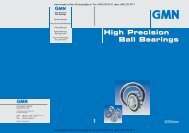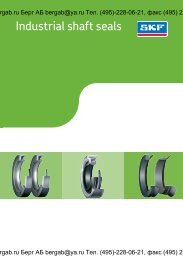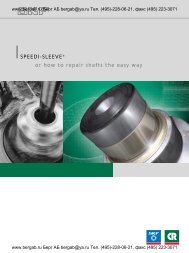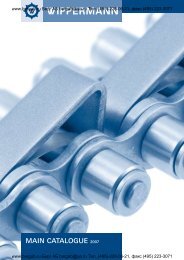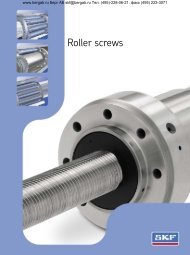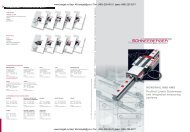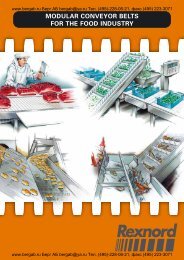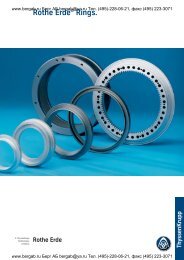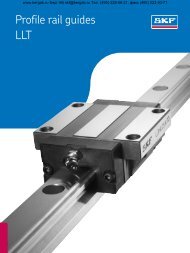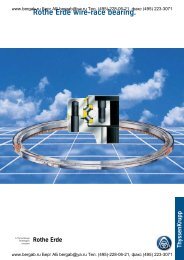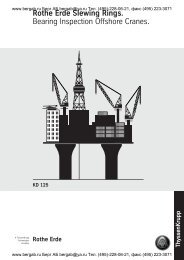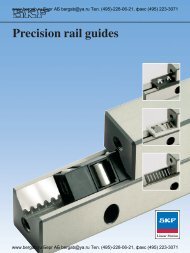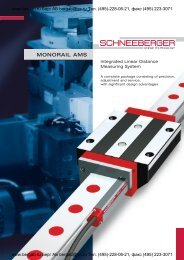Chains
Chains
Chains
Create successful ePaper yourself
Turn your PDF publications into a flip-book with our unique Google optimized e-Paper software.
Conveyor<br />
Design<br />
www.bergab.ru Берг АБ bergab@ya.ru Тел. (495)-228-06-21, факс (495) 223-3071<br />
Straight Running and Sideflexing <strong>Chains</strong><br />
Carrying way<br />
In figure 1, types A,B and C illustrate possible arrangements for carrying<br />
ways and wear strips. The wear strips are attached to the surface of the<br />
carrying way.<br />
They should be slightly wider than the underside of the chain plates.<br />
Types A and B show different possibilities for single-strand conveyors.<br />
Type C illustrates the separation of two parallel chains running either in<br />
the same or opposite directions.<br />
In order to prevent contact and subsequent damage, a narrow edge<br />
separates the chains.<br />
Unless extremely accurate chains guidance is required, chains running in<br />
the same direction at the same speed do not require separation.<br />
Wearstrips transfers<br />
On straight sections with a length of more than 3 metres, or for high<br />
(40° - 70°C) application temperatures, we recommend to divide the<br />
wearstrip into several sections, because of the thermal expansion of the<br />
strips. The size of clearance is depending on the expected elongation<br />
due to e.g. thermal expansion, see drawing.<br />
Clearance C depends on wearstrip length<br />
and environmental temperatures. Example :<br />
For MARBETT UHMWPE material the<br />
coefficient of expansion is :<br />
GC<br />
Type A<br />
GC<br />
Type B<br />
C<br />
0.2 mm/m/°C<br />
A temperature increase of 40°C would<br />
elongate a 2 meter wearstrip with :<br />
40°C • 2 mtr. • 0.2 = 16 mm<br />
In this case, the gap between the wearstrips<br />
should be a bit larger than 16 mm, e.g. 17<br />
mm.<br />
GC<br />
Type C<br />
GC<br />
Note<br />
It is recommended to cut the wearstrips at double 45°. This provides for<br />
smooth chain transfers.<br />
Fig. 1 - Arrangements of chain carrying way and wear strip<br />
Table 1 below gives the recommended clearance (GC)between chains<br />
and wear strips.<br />
Chain No.<br />
512<br />
802 - 805<br />
812 - 815<br />
SSR 812 K125/175<br />
866<br />
1864<br />
820 - 831<br />
821<br />
843 - 845<br />
963<br />
Guide clearance (GC)<br />
44,5<br />
82<br />
44<br />
23,5<br />
41,3<br />
34,9<br />
44,5<br />
140<br />
23,8<br />
36,5<br />
Table 1 - guide clearance (GC) for staight running chains<br />
When mounting the wearstrips, make sure only the infeed side of the<br />
wearstrip is fixed to the conveyor frame to avoid bulging of the<br />
wearstrips.<br />
Chamfering of wearstrips<br />
Wearstrips should always be chamfered at the beginning of the strip<br />
(where strips are fixed). Chamfering of wearstrips reduces the risk of<br />
chain-obstruction. This way, the chain or belt is smoothly guided through<br />
the conveyor.<br />
The wearstrips should be chamfered at the sides and at the top.<br />
In the drawing is shown what a proper chamfered wearstrip should look<br />
like.<br />
Calculation of thermal expansion<br />
Lt = L0 • [ 1 + a • ( T – 20°C ) ]<br />
Lt = final length (mm.)<br />
L0 = initial length (mm.)<br />
a = coefficient of linear expansion.<br />
T = operating temperature (°C).<br />
20 °C = ambient temperature.<br />
Example :<br />
a guide having initial length L0 = 1000 mm, coefficient of linear expansion<br />
2X10 -4 , and an operating temperature of 70 °C, expands by :<br />
Lt = 1000 mm • [ 1 + 0,0002 • ( 70 °C - 20 °C ) ] = 1010 mm<br />
Fig. 2 - Chamfering of wearstrips<br />
Note<br />
Other information and ideas on conveyor design can be found on<br />
MARBETT CONVEYOR COMPONENTS catalogue<br />
www.bergab.ru Берг АБ bergab@ya.ru Тел. 98 (495)-228-06-21, факс (495) 223-3071



